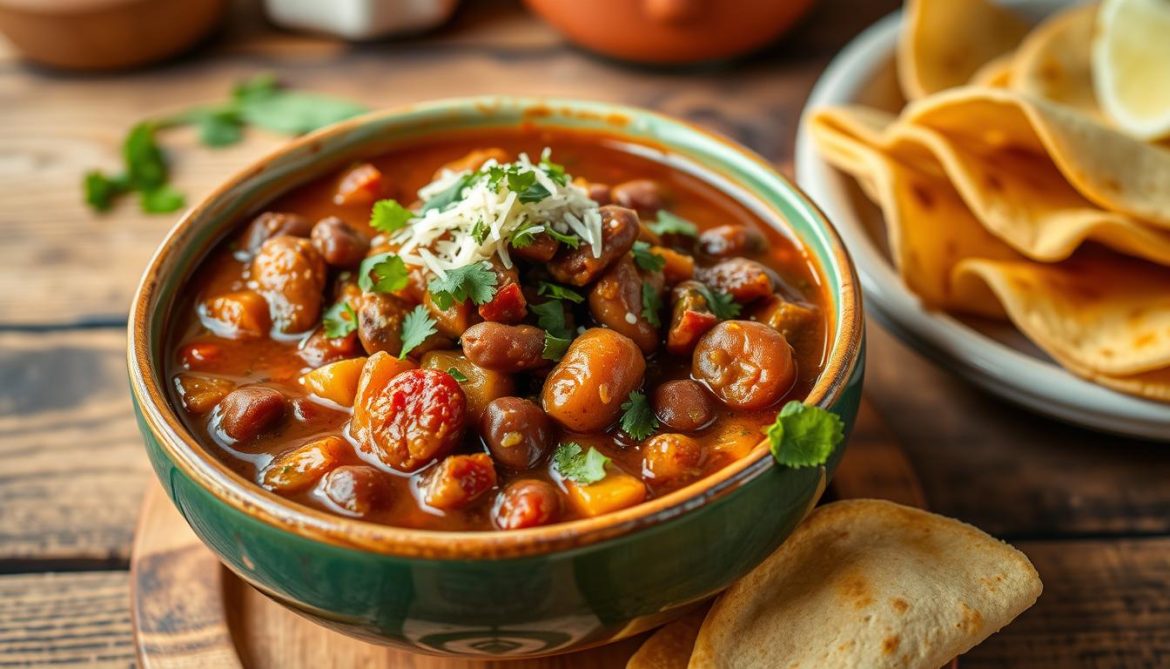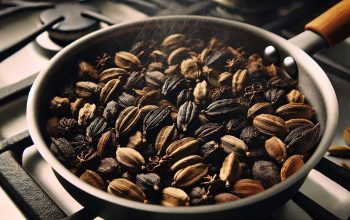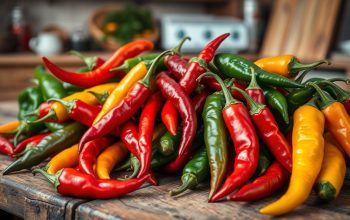The poblano chili is a key part of Mexico’s rich food culture. It’s loved worldwide for its unique taste and shape. This pepper adds warmth and depth to many favorite dishes.
The poblano chili is more than food; it’s a symbol of Mexican traditions. It’s celebrated in markets and festivals across the country. It shows Mexico’s deep love for food.
The poblano chili is used in many ways, like being roasted or in mole sauce. It brings a special flavor to every dish. Its versatility makes it a must-have in Mexican cooking, delighting everyone who tries it.
Key Takeaways
- The poblano chili is a cornerstone of authentic Mexican cuisine, known for its distinctive shape and subtle heat.
- This iconic pepper is deeply rooted in Mexican culture, celebrated in traditions and festivals across the country.
- The poblano chili’s versatility allows it to transform a wide range of dishes, adding depth, complexity, and a comforting warmth.
- From roasted and stuffed to simmered in mole sauce, the poblano chili is an indispensable ingredient in the Mexican culinary repertoire.
- The poblano chili’s unique flavor profile and adaptability make it a beloved staple in both Mexican and international cuisine.
Introduction to Mexico’s Beloved Poblano Chili
The poblano chili is a favorite in Mexican food. It comes from the capsicum annuum family. People all over love it for its special taste and how it makes dishes richer.
It comes from Puebla, Mexico. It’s known for its heart shape and green color. Sometimes, it turns red. Its mild heat makes it great for many dishes.
“The poblano chili is the unsung hero of the capsicum annuum family, offering a complex flavor that is both comforting and nuanced.”
The poblano is used in many ways. It’s roasted, stuffed, or added to sauces and stews. It’s a big part of Mexican food, showing the country’s rich culture and cooking skills.
We’ll look closer at the poblano’s history, importance, and uses in Mexican food. We’ll see why it’s a key part of real Mexican dishes.
Origins and Cultural Significance of Poblano Chili
The poblano chili is a favorite in mexican cuisine. It comes from the lively city of Puebla, Mexico. This pepper has been a key part of Mexican food for centuries, showing its deep cultural value.
Historical Roots in Puebla, Mexico
The poblano chili comes from Puebla, known for its tasty dishes. The pepper’s name comes from Puebla city, where it’s grown and loved for ages. It’s a main ingredient in many stuffed peppers and Mexican dishes, adding flavor and depth.
Traditional Uses in Mexican Cuisine
- Stuffed Poblano Peppers (Chiles Rellenos): A classic Mexican dish with roasted and peeled poblano peppers. They’re filled with cheese, meat, or veggies.
- Mole Poblano: A rich sauce made with poblano chilies, chocolate, and spices. It’s a favorite in Puebla and Mexico.
- Rajas con Crema: Sliced, roasted poblano peppers in a creamy sauce. It’s often served as a side or in tacos.
Cultural Celebrations and Poblano
The poblano chili is a big deal in Mexican culture. It’s a star at many festivals, like Cinco de Mayo and Day of the Dead. It shows the pepper’s important role in Mexico’s food and culture.
“The poblano chili is more than just a pepper – it’s a symbol of Mexico’s rich culinary traditions and the pride of the Pueblan people.”
Understanding the Capsicum Annuum Family
The poblano chili comes from the capsicum annuum family. This group includes many chile pepper types from the Americas. They vary in shape, size, and taste, from hot habaneros to sweet bell peppers. Knowing about the capsicum annuum family helps us see the beauty of the poblano chili.
Poblano peppers, or chile poblano, are a special type in the capsicum annuum species. They have big, heart-shaped pods and a deep green color. Their flavor is rich and earthy, and they are not very spicy. This makes them great for many dishes in Mexican cooking.
- Poblano peppers are a member of the capsicum annuum family, which includes a wide variety of chile peppers.
- Poblanos are characterized by their large, heart-shaped pods, deep-green color, and mild to moderate heat level.
- The capsicum annuum family encompasses a diverse range of chile pepper varieties, each with its own unique flavor profile and culinary applications.
“The capsicum annuum family is a culinary treasure trove, with each variety offering its own distinct personality and culinary potential.”
Exploring the capsicum annuum family helps us understand the poblano chili better. It also opens up new ways to use this favorite ingredient in our cooking.
Identifying Fresh Poblano Peppers: A Buyer’s Guide
The poblano pepper is a key ingredient in Mexican cuisine. It’s used in dishes like chiles rellenos and spicy sauces. To get the best flavor, choose the freshest, highest-quality peppers. Here’s what to look for when shopping.
Color and Appearance Characteristics
Fresh poblanos are deep green with a smooth, glossy skin. Steer clear of peppers with blemishes or discoloration. They should be broad, slightly tapered, and firm, with a slight give when squeezed.
Seasonal Availability
Poblanos are at their best in summer and early fall. This is when they’re most abundant and of the highest quality. Look for them at farmers’ markets or specialty stores during these months.
Storage Tips and Shelf Life
- Keep fresh poblanos in the fridge in a perforated plastic or paper bag.
- They can last up to a week in the fridge if stored right.
- Don’t store them with produce that releases ethylene gas, as it can make them spoil faster.
By following these tips, you can pick the perfect poblanos for your Mexican dishes. Enjoy their vibrant flavor and versatility!
The Transformation: Fresh Poblano vs Dried Ancho
The journey from fresh poblano peppers to dried ancho chili is fascinating. It shows how flavor and versatility change. This makes dried ancho chili a key part of Mexican cooking.
The process starts with the poblano, a mild and sweet pepper. It’s a mainstay in Mexican dishes. Through careful steps, it turns into the rich, complex ancho chili.
Drying and Aging: The Secret to Ancho Perfection
The drying and aging process brings out the ancho’s flavor. Fresh poblanos are dried under the sun or in a low oven. This concentrates the pepper’s sugars and enhances its earthy, sweet-spicy taste.
As they dry, the peppers change color, texture, and smell. They go from green to a deep, reddish-brown. The dried ancho chili becomes soft and flexible, great for many dishes.
Culinary Versatility: Fresh vs. Dried
Fresh poblano and dried ancho chilies are different in taste and texture. Fresh poblanos have a mild, grassy flavor. Dried anchos have a complex, almost chocolatey taste with hints of raisin and tobacco.
In cooking, these differences are useful. Fresh poblanos are best in chiles rellenos for their delicate taste. Dried anchos add depth to stews, sauces, and marinades, essential in many Mexican dishes.
“The transformation from fresh poblano to dried ancho is a testament to the ingenuity and creativity of Mexican cuisine. Each form offers unique culinary possibilities, making them a dynamic duo in the kitchen.”
Heat Level: Where Poblanos Sit on the Scoville Scale
The Scoville scale is key for measuring chili pepper heat. It ranks peppers by their capsaicin, which gives them their spicy taste. Poblanos, a staple in Mexican cooking, have a lower Scoville rating.
Comparing Heat with Other Peppers
Poblanos have a heat level of 1,000 to 1,500 Scoville heat units (SHU). This is milder than jalapeños, which range from 2,500 to 8,000 SHU. Habaneros, on the other hand, can be as hot as 100,000 to 350,000 SHU. Poblanos are great for those who want flavor without too much spice.
Flavor Profile Beyond Heat
The Scoville scale only tells part of the story. Poblanos are known for their rich and slightly sweet taste. They also have earthy and smoky notes, making them versatile in Mexican dishes.
| Pepper Variety | Scoville Heat Units (SHU) |
|---|---|
| Poblano | 1,000 – 1,500 |
| Jalapeño | 2,500 – 8,000 |
| Habanero | 100,000 – 350,000 |
Poblanos’ mild heat and complex flavor make them a hit in Mexican cooking. They add depth to dishes without overpowering them. Knowing the Scoville heat scale and the unique qualities of different chile pepper varieties helps unlock their full potential.
Essential Kitchen Tools for Preparing Poblano Chili
Making authentic Mexican poblano chili needs the right kitchen tools. From roasting to peeling, the right gear enhances flavor and texture. Let’s look at the must-have tools for a great poblano chili.
Roasting Essentials
- Roasting Pans: Wide, heavy pans are crucial for even charring. Choose pans with raised edges to catch juices.
- Grill Grates: Grilling adds a smoky taste. Get high-quality grates for even heat.
- Baking Sheets: Use a rimmed baking sheet for oven-roasting. It catches juices and prevents mess.
Peeling and Cleaning Tools
- Paring Knife: A sharp knife is key for removing charred skin. It keeps the flesh intact.
- Vegetable Peeler: A good peeler makes peeling easy. It gives a smooth texture.
- Cleaning Brush: A soft-bristled brush helps remove skin and seeds. It’s gentle yet effective.
With these tools, you’re ready to make perfect poblano chili dishes. They bring the true taste of Mexican cuisine to your table.
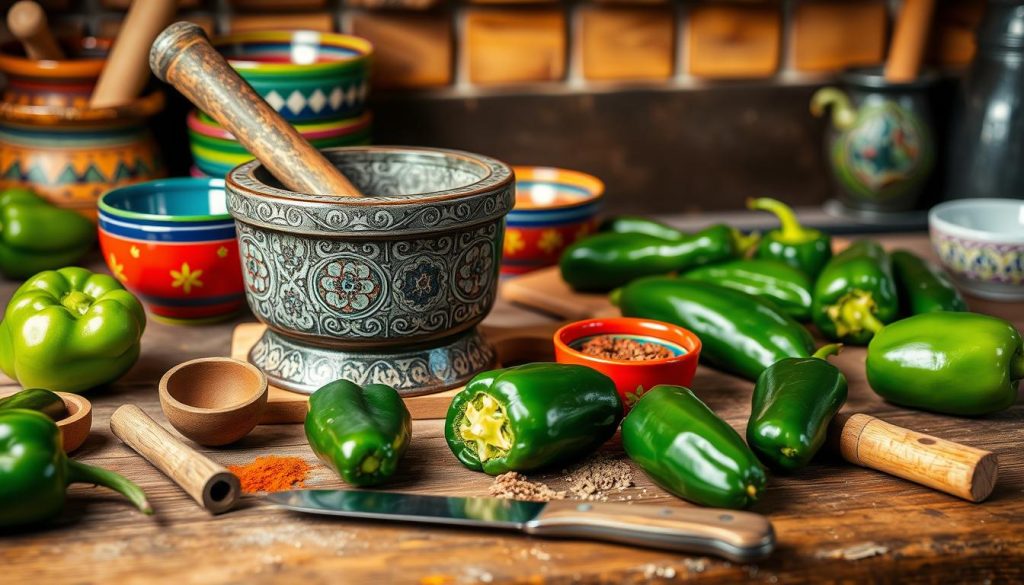
Traditional Roasting Techniques for Perfect Poblanos
Roasting poblano peppers brings out their rich, smoky flavor and tender texture. You can use an open flame or the oven to roast them. Learning these traditional techniques will help you roast poblano chili perfectly every time.
Open Flame Method
The open flame method is a classic way to roast poblano peppers. Start by placing the peppers over a gas burner or grill set to high heat. Use tongs to rotate the peppers, ensuring even charring on all sides.
Once the skin is blackened and blistered, move the peppers to a bowl. Cover them with a lid or plastic wrap. This steaming process will make the skin easy to peel.
Oven Roasting Tips
Oven roasting is a great option if you prefer a hands-off method. Preheat your oven to 400°F (200°C). Line a baking sheet with foil or parchment paper.
Arrange the poblano peppers in a single layer. Roast for 20-25 minutes, flipping halfway through. This will char and blister the skin.
Peeling and Cleaning Process
After roasting, it’s time to peel and clean the peppers. Let them cool slightly before peeling. Use your fingers or a paring knife to remove the charred skin.
Be careful not to throw away any flavorful flesh. Finally, slice the peppers in half lengthwise. Remove the seeds and membranes. This leaves you with perfectly prepared Mexican cuisine ingredients.
Classic Mexican Recipes Featuring Poblano Chili
Poblano chili is a key ingredient in many Mexican dishes. It’s found in chili relleno and stews, adding flavor and authenticity to Mexican food.
The chili relleno is a famous dish made with poblano chili. It’s roasted, peeled, stuffed with cheese, dipped in batter, and fried. This dish is a perfect mix of textures and tastes, showing off the richness of Mexican cuisine.
Rajas con crema is another favorite, with sautéed poblano strips in a creamy sauce. It’s a comforting dish that brings out the sweet and slightly spicy flavors of the peppers. It’s great as a side or topping for many Mexican dishes.
| Dish | Description |
|---|---|
| Chili Relleno | Roasted and peeled poblano chili stuffed with cheese, dipped in batter, and fried |
| Rajas con Crema | Sautéed strips of roasted poblano chili in a creamy sauce |
| Chicken in Creamy Poblano Sauce | Tender chicken simmered in a rich, velvety sauce made with roasted chili relleno |
Poblano chili is also great in stews, like chicken in creamy poblano sauce. It adds a unique flavor and aroma to the dish. This makes poblano chili a must-have in mexican cuisine.
“The poblano chili is the heart and soul of Mexican cooking. It adds depth, warmth, and a touch of magic to so many beloved dishes.”
Stuffed Poblano Peppers: Modern Interpretations
The poblano pepper is a key part of Mexican cuisine. It’s used in many ways, including in stuffed poblano peppers. Chefs and home cooks are finding new ways to use this vibrant ingredient.
Vegetarian Filling Options
Looking for a meat-free option? There are many tasty vegetarian fillings for stuffed poblanos. You can try rice, beans, and cheese or mix sautéed mushrooms, spinach, and quinoa. These options are healthy and delicious.
Meat-Based Variations
Meat lovers will enjoy stuffed poblano peppers too. You can fill them with ground beef, shredded chicken, or chorizo. Add spices, diced tomatoes, and cheese for a hearty dish. These peppers are great as a main course or side dish.
The secret to great stuffed poblanos is preparing and roasting the peppers well. Use traditional methods like charring over an open flame or oven roasting. This brings out the pepper’s flavor, matching it perfectly with the filling.
Stuffed poblano peppers are a tasty and flexible choice. They’re perfect for family meals or trying new recipes. These vibrant peppers are loved by many for their flavor and versatility.
Health Benefits and Nutritional Value
Poblano chilies, part of the capsicum annuum family, add more than flavor to Mexican dishes. They are full of nutrients and health perks, making them great for any diet.
Rich in Vitamins and Minerals:
- Poblano chilies are a top source of vitamin C, giving you up to 40% of your daily needs in one serving.
- They also have lots of vitamin A, key for good vision and skin health.
- These peppers are rich in potassium, important for blood pressure and heart health.
Antioxidant Power:
- Poblano chilies are full of antioxidants like lutein and zeaxanthin, protecting cells from damage.
- The capsaicin in poblano peppers fights inflammation, which may lower disease risk.
Digestive and Immune Support:
- Poblano chilies have dietary fiber, helping your digestive system and keeping you full.
- They also have vitamin B6, crucial for your immune system and making red blood cells.
| Nutrient | Amount per 100g |
|---|---|
| Calories | 25 |
| Total Fat | 0.3g |
| Carbohydrates | 5.8g |
| Dietary Fiber | 1.8g |
| Vitamin C | 43mg |
| Vitamin A | 31μg |
| Potassium | 260mg |
Adding poblano chilies to your cooking not only makes food taste better but also boosts your health. Discover the health benefits of this capsicum annuum variety and enjoy the vibrant health perks it offers.
Growing Poblano Peppers in Your Garden
If you love the taste of capsicum annuum, also known as poblano chili, why not grow them yourself? With the right care, you can enjoy picking your own poblano peppers.
First, you need good soil that drains well and is rich in nutrients. Poblanos do best in soil with a pH of 6.0 to 7.0. Before planting, mix compost or aged manure into the soil. This will give your plants the nutrients they need. Choose a spot that gets at least 6 hours of direct sunlight every day.
- Plant your poblano seedlings or transplants after the last frost, spacing them 18-24 inches apart.
- Water the plants regularly, about 1-2 inches per week, but avoid overwatering.
- As the plants grow, support them with stakes or cages. This keeps the fruits off the ground.
- Keep an eye out for pests and diseases. Deal with any problems quickly to keep your plants healthy.
- Pick your poblano peppers when they’re deep green and firm, with a glossy look.
With patience and care, you’ll get a big harvest of fresh, tasty poblano chili peppers. Use them in your favorite Mexican dishes. Growing your own capsicum annuum at home is very rewarding!
“Growing your own poblano peppers is a rewarding experience that allows you to bring the authentic flavors of Mexican cuisine right to your doorstep.”
Poblano vs Hatch Chili: Understanding the Differences
Poblano and hatch chilies are two different types of chile pepper. Each has its own taste and uses in cooking. Knowing the differences can help you choose the right pepper for your dishes.
Flavor Comparison
Poblano peppers have a mild, earthy, and sweet taste. They are not very hot, with a Scoville heat of 1,000 to 1,500. Hatch chilies, on the other hand, are spicier and more pungent. Their heat can range from 3,000 to 8,000 Scoville units, making them hotter than poblanos.
Culinary Applications
- Poblano peppers are great in Mexican dishes like chiles rellenos, sauces, and stews.
- Hatch chilies add smoky and fruity flavors to Southwestern dishes, like green chile recipes, burgers, and salsas.
- Both peppers can be roasted and used in many recipes, adding flavor and depth.
Understanding the unique qualities of poblano and hatch chilies helps you explore the world of chile pepper varieties. It makes choosing the right pepper for your dishes easier, especially when cooking Mexican and Southwestern food.
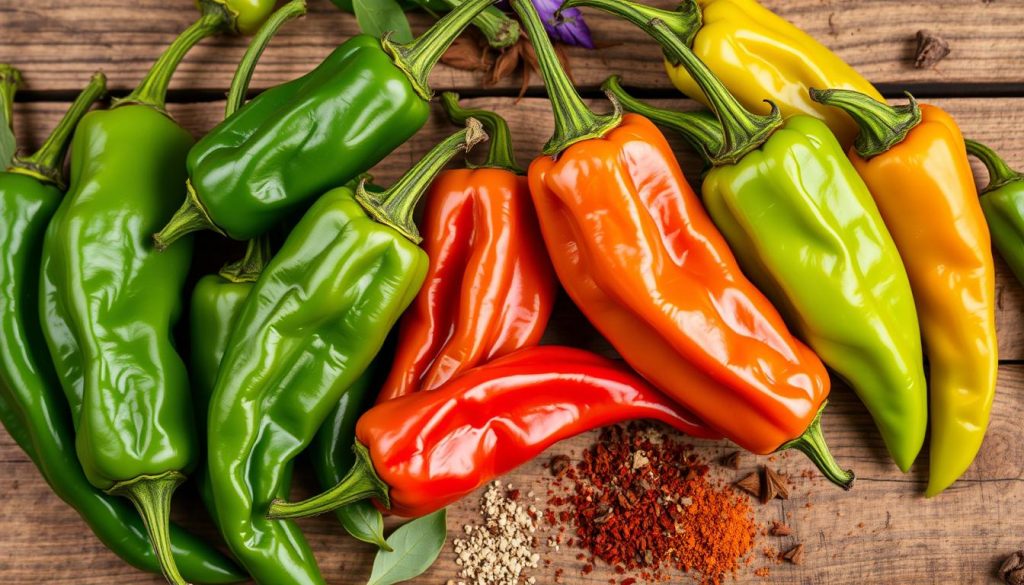
Preserving and Storing Techniques
Learning how to keep your dried chili and ancho chili fresh is key. Whether you want to keep your fresh poblano peppers or dried chilies tasty, we’ve got tips for you.
Freezing Fresh Poblano Peppers
Freezing is a great way to keep fresh poblano peppers tasty. Roast, peel, and seed the peppers. Then, put the halves in airtight bags or containers.
This method keeps the peppers’ oils in and prevents freezer burn. Your peppers will stay fresh for up to 12 months.
Drying and Storing Ancho Chilies
To store ancho chili for a long time, dry and package them right. Air-drying is traditional, but a dehydrator speeds up the process. Once dry, store them in airtight containers or bags.
Keep them away from light and moisture to preserve their flavor. This way, your ancho chilies will stay flavorful for months.
- Avoid sunlight to keep the chilies’ color and strength
- Use vacuum-sealing or desiccant packs to last longer
- Whole dried ancho chilies last 6-12 months; ground powder lasts 3-6 months
Mastering these preservation methods lets you enjoy Mexico’s dried chili and ancho chili flavors long after they’re picked or bought. Try different methods to find what works best for you. Then, enjoy the delicious results in your kitchen.
Wine and Beverage Pairings with Poblano Dishes
The poblano chili is a key ingredient in Mexican cuisine, known for its versatility. It pairs well with many drinks, whether you’re enjoying a stuffed poblano or a spicy dish. The right wine or drink can make your meal even better.
Red wine lovers might enjoy a medium-bodied Malbec or a full-bodied Tempranillo with poblano dishes. These wines match the poblano’s smoky and mild heat with their fruity flavors. For something lighter, a crisp Sauvignon Blanc or a zesty Albariño can cut through the dish’s richness with its acidity.
But you don’t need wine to enjoy poblano chili. Non-alcoholic drinks can also bring out the flavors. A creamy Mexican horchata or a tangy tamarind agua fresca can cool down the poblano’s heat. A refreshing hibiscus tea can also complement the dish’s bold flavors.
